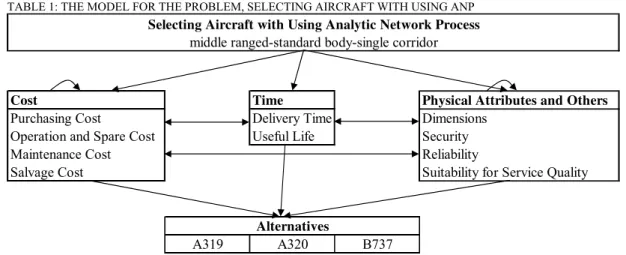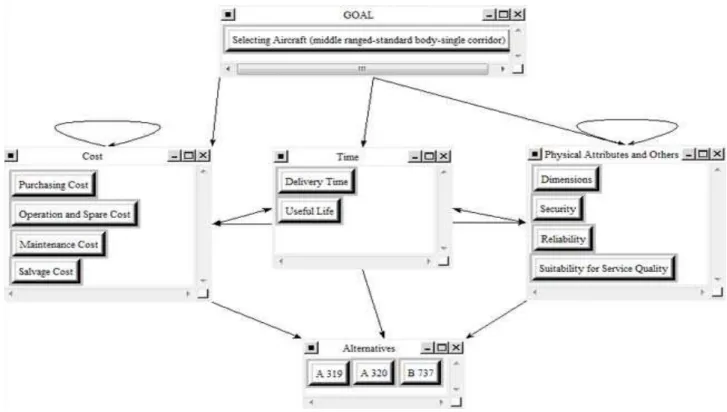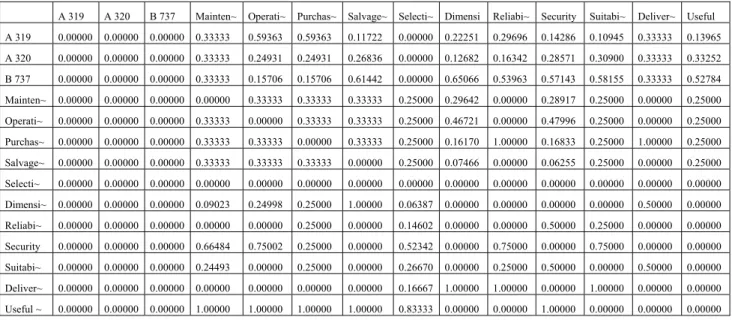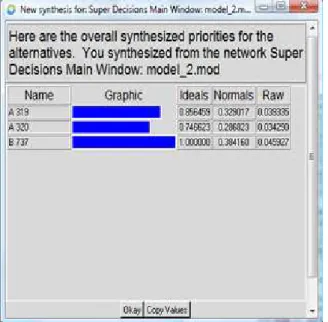Abstract— Nowadays airway transportation is the fastest type of transportation. With advancement of the aviation technologies, the plane's increased speed, and a lot of companies that entering to the airway transportation sector, leads to the conclusion that rising competition and decreased prices. Such an important sector, each type of investments have to be feasible and logical, e.g. airport location, aircraft purchase, services, crews and their assignment etc. Because of purchasing, renting or chartering aircrafts, their needs for maintenance and having a fleet are the biggest costs for airline companies. For this reason in this paper we study selecting aircraft to purchase for the biggest Turkish airline company, Turkish Airlines using one of the multi criteria-decision making techniques, Analytic Network Process (ANP).
Index Terms— aircraft, Analytic Network Process (ANP), decision making, Multi-Criteria Decision Making (MCDM)
I. INTRODUCTION
In recent years, decreasing of the ticket prices in the aviation sector caused the passengers to prefer airline transport rather than others, because these prices almost can be compared with the ticket prices in other transportation types. This change also created a competitive airline market. For this reason airline companies need professional decisions for all of their activities.
THY – Turkish Airlines is the national flag carrier airline of Turkey, and it operates scheduled services to 130 international and 41 domestic cities (38 domestic airports), serving a total of 171 airports, in Europe, Asia, Africa, and the Americas. As of February 2011, the Turkish Airlines fleet (excluding subsidiaries) consists of 152 passenger and 5 cargo aircraft with an average age of 6.8 years [1]. THY is the biggest airline company in Turkey, and it has the biggest market share.
Multi-Criteria Decision Making is a well known branch of decision making. It is a branch of a general class of operations research models which deal with decision problems under the presence of a number of decision criteria. This major class of models is very often called MCDM. This class is further divided into multi objective decision making (MODM) and multi-attribute decision making (MADM) [2]. There are several methods in each of the above categories. Priority based, outranking, distance
Manuscript received March 08, 2011.
Y.Ozdemir is with the Yildiz Technical University, Besiktas, Istanbul 34349 TURKEY (corresponding author to provide phone: 00902123832923; fax: 00902122616659; e-mail: ozdemiry@yildiz.edu.tr).
H. Basligil is with the Yildiz Technical University, Besiktas, Istanbul 34349 TURKEY (e-mail: basligil@yildiz.edu.tr).
M. Karaca is with the Yildiz Technical University, Besiktas, Istanbul 34349 TURKEY (e-mail: mervekaraca2@gmail.com)
based and mixed methods are also applied to various problems. Each method has its own characteristics and the methods can also be classified as deterministic, stochastic and fuzzy methods. There may be combinations of the above methods [3].
In this paper we deal with one of the airline companies’ problems, selecting aircraft to purchase, using one of multi criteria-decision making techniques, Analytic Network Process (ANP), because this problem has several criteria and several alternatives for decision making as stated in the 3rd section. The rest of this paper is organized as follows: Section 2 includes a brief introduction to ANP, in Section 3 an application for aircraft selection using ANP is presented. The last section summarizes the findings and makes suggestions for further research.
II. ANALYTIC NETWORK PROCESS
Selecting or prioritizing alternatives from a set of available alternatives with respect to multiple criteria, is often refer to Multi-Criteria Decision Making (MCDM). Analytic Hierarchy Process (AHP) and Analytic Network Process (ANP) are the common methods by which to solve Multi-Criteria Decision Making problems. The decision problem is structured hierarchically at different levels in both methodologies [4]. The local priorities in ANP are established in the same manner as they are in AHP using pairwise comparisons and judgments [5]. The Analytical Network Process is the generalization of Saaty’s Analytical Hierarchy Process, which is one of the most widely employed decision support tools [6]. Similarly to the AHP, the priorities in the ANP are assessed indirectly from pairwise comparisons judgments [7]. There are four general steps in ANP based multicriteria decision-making process, including model construction; paired comparisons between each two clusters or nodes; supermatrix calculation based on results from paired comparisons; and result analysis for the assessment [8,9].
For the proposed ANP algorithm the steps are as shown below:
Step 1: Analyze the problem, and determine the main goal.
Step 2: Determine the criteria and sub-criteria that effect the main goal.
Step 3: Determine alternatives for the problem.
Step 4: Determine the interactions between criteria, sub-criteria, and alternatives respect to the main goal. Step 5: Construct supermatrix according to the network, and then construct weighted supermatrix and limit supermatrix. In a supermatrix each
Aircraft Selection Using Analytic Network
Process: A Case for Turkish Airlines
element is represented at one row and one respective column. If the column sum of any column in the composed supermatrix is greater than 1, that column will be normalized. Such a supermatrix is called as weighted supermatrix. The weighted supermatrix is then raised to a significantly large power in order to have the converged or stable values. The values of this limit matrix are the desired priorities of the elements with respect to the goal [10].
Step 6: Choose the best alternative with the highest priority.In the literature, ANP method has been used to solve problems like Research and Development Project Selection [11], Performance Evaluation [12], Quality Function Deployment Implementation [13], Enterprise Resource Planning (ERP) Software Selection [14]. In this paper, Saaty’s ANP [8] is used for the biggest Turkish airlines company’s, Turkish Airlines, aircraft selection process.
III. AIRCRAFTSELECTIONUSINGANALYTIC NETWORKPROCESS
For the numerical example in this study, aircraft selection problem has chosen and for this problem ANP
approach has used. The biggest Turkish airline company, Turkish Airlines, requires purchasing middle ranged standard body, and single corridor aircraft. For this problem decision criteria and alternatives have defined with experts as seen on Table 1. In this paper main criteria are; cost, time, and physical attributes and others.
Cost criteria: This main criteria includes the sub-criteria explaining about financial decisions. Sub-criteria under this title include “Purchasing Cost”, “Operation and Spare Cost”, “Maintenance Cost”, and “Salvage Cost”.
Time criteria: Under the time criteria there are these sub-criteria; “Delivery Time” and the “Useful Life” of the aircraft.
Physical Attributes and Others: Under the physical attributes and others criteria these sub-criterias can be thought; “Dimensions”, “Security”, “Reliability”, and “Suitability for Service Quality”.
As seen on Table 1 and Figure 1, the alternatives for aircraft selection are A319, A320, and B737. In Figure 1 the model that written to Super Decisions software can be seen.
After the purpose, criteria and alternatives have determined, binary comparisons have done. After all of binary comparisons have completed, these comparisons data are entered to Super Decisions software as in Figure 2.
TABLE 1: THE MODEL FOR THE PROBLEM, SELECTING AIRCRAFT WITH USING ANP
Cost Time Physical Attributes and Others
Purchasing Cost Delivery Time Dimensions
Operation and Spare Cost Useful Life Security
Maintenance Cost Reliability
Salvage Cost Suitability for Service Quality
A319 A320 B737
Selecting Aircraft with Using Analytic Network Process middle ranged-standard body-single corridor
FIGURE 1: THE RELATION BETWEEN GOAL, CRITERIA AND THE ALTERNATIVES
FIGURE 2: ENTERING DATA TO SUPER DECISIONS SOFTWARE
The supermatrix used in this paper is as follows:
W =
1 3
2 4
0 0 0
0 0
w W W W
(1)
where w1 is a vector that represents the impact of the
goal on the criteria (CRs). W2 is a matrix that denotes the
impact of the CRs on each of the alternatives (ALTs), W3
and W4 are the matrices that represent the inner
dependence of the CRs and the inner dependence of the ALTs, respectively. After all of data have entered the program, lastly the result can be found. For our problem, the unweighted supermatrix, weighted supermatrix and limit supermatrix are shown in Table 2, 3, and 4, respectively.
Goal(G) CRs ALTs
TABLE 2: UNWEIGHTED SUPERMATRIX
A 319 A 320 B 737 Mainten~ Operati~ Purchas~ Salvage~ Selecti~ Dimensi Reliabi~ Security Suitabi~ Deliver~ Useful
A 319 0.00000 0.00000 0.00000 0.33333 0.59363 0.59363 0.11722 0.00000 0.22251 0.29696 0.14286 0.10945 0.33333 0.13965
A 320 0.00000 0.00000 0.00000 0.33333 0.24931 0.24931 0.26836 0.00000 0.12682 0.16342 0.28571 0.30900 0.33333 0.33252
B 737 0.00000 0.00000 0.00000 0.33333 0.15706 0.15706 0.61442 0.00000 0.65066 0.53963 0.57143 0.58155 0.33333 0.52784
Mainten~ 0.00000 0.00000 0.00000 0.00000 0.33333 0.33333 0.33333 0.25000 0.29642 0.00000 0.28917 0.25000 0.00000 0.25000
Operati~ 0.00000 0.00000 0.00000 0.33333 0.00000 0.33333 0.33333 0.25000 0.46721 0.00000 0.47996 0.25000 0.00000 0.25000
Purchas~ 0.00000 0.00000 0.00000 0.33333 0.33333 0.00000 0.33333 0.25000 0.16170 1.00000 0.16833 0.25000 1.00000 0.25000
Salvage~ 0.00000 0.00000 0.00000 0.33333 0.33333 0.33333 0.00000 0.25000 0.07466 0.00000 0.06255 0.25000 0.00000 0.25000
Selecti~ 0.00000 0.00000 0.00000 0.00000 0.00000 0.00000 0.00000 0.00000 0.00000 0.00000 0.00000 0.00000 0.00000 0.00000
Dimensi~ 0.00000 0.00000 0.00000 0.09023 0.24998 0.25000 1.00000 0.06387 0.00000 0.00000 0.00000 0.00000 0.50000 0.00000
Reliabi~ 0.00000 0.00000 0.00000 0.00000 0.00000 0.25000 0.00000 0.14602 0.00000 0.00000 0.50000 0.25000 0.00000 0.00000
Security 0.00000 0.00000 0.00000 0.66484 0.75002 0.25000 0.00000 0.52342 0.00000 0.75000 0.00000 0.75000 0.00000 0.00000
Suitabi~ 0.00000 0.00000 0.00000 0.24493 0.00000 0.25000 0.00000 0.26670 0.00000 0.25000 0.50000 0.00000 0.50000 0.00000
Deliver~ 0.00000 0.00000 0.00000 0.00000 0.00000 0.00000 0.00000 0.16667 1.00000 1.00000 0.00000 1.00000 0.00000 0.00000
Useful ~ 0.00000 0.00000 0.00000 1.00000 1.00000 1.00000 1.00000 0.83333 0.00000 0.00000 1.00000 0.00000 0.00000 0.00000
TABLE 3: WEIGHTED SUPERMATRIX
A 319 A 320 B 737
Mainten ~
Operati
~ Purchas~ Salvage~ Selecti~ Dimensi Reliabi~ Security Suitabi~ Deliver~ Useful ~
A 319 0.0000 0 0.0000 0 0.0000
0 0.03468 0.06176 0.06176 0.01219 0.00000 0.02496 0.03090 0.01486 0.01139 0.05984 0.02794
A 320 0.0000 0 0.0000 0 0.0000
0 0.03468 0.02594 0.02594 0.02792 0.00000 0.01423 0.01700 0.02973 0.03215 0.05984 0.06652
B 737 0.0000 0 0.0000 0 0.0000
0 0.03468 0.01634 0.01634 0.06392 0.00000 0.07299 0.05615 0.05946 0.06051 0.05984 0.10559
Mainten~ 0.0000 0 0.0000 0 0.0000
0 0.00000 0.21821 0.21821 0.21821 0.18265 0.20922 0.00000 0.18930 0.16366 0.00000 0.19999
Operati~ 0.0000 0 0.0000 0 0.0000
0 0.21821 0.00000 0.21821 0.21821 0.18265 0.32977 0.00000 0.31419 0.16366 0.00000 0.19999
Purchas~ 0.0000 0 0.0000 0 0.0000
0 0.21821 0.21821 0.00000 0.21821 0.18265 0.11413 0.65462 0.11019 0.16366 0.71789 0.19999
Salvage~ 0.0000 0 0.0000 0 0.0000
0 0.21821 0.21821 0.21821 0.00000 0.18265 0.05270 0.00000 0.04095 0.16366 0.00000 0.19999
Selecti~ 0.0000 0 0.0000 0 0.0000
0 0.00000 0.00000 0.00000 0.00000 0.00000 0.00000 0.00000 0.00000 0.00000 0.00000 0.00000
Dimensi~ 0.0000 0 0.0000 0 0.0000
0 0.00654 0.01813 0.01813 0.07254 0.00517 0.00000 0.00000 0.00000 0.00000 0.05129 0.00000
Reliabi~ 0.0000 0 0.0000 0 0.0000
0 0.00000 0.00000 0.01813 0.00000 0.01182 0.00000 0.00000 0.03627 0.01813 0.00000 0.00000
Security 0.0000 0 0.0000 0 0.0000
0 0.04822 0.05440 0.01813 0.00000 0.04238 0.00000 0.05440 0.00000 0.05440 0.00000 0.00000
Suitabi~ 0.0000 0 0.0000 0 0.0000
0 0.01777 0.00000 0.01813 0.00000 0.02160 0.00000 0.01813 0.03627 0.00000 0.05129 0.00000
Deliver~ 0.0000 0 0.0000 0 0.0000
0 0.00000 0.00000 0.00000 0.00000 0.03140 0.18199 0.16879 0.00000 0.16879 0.00000 0.00000
Useful ~ 0.0000 0 0.0000 0 0.0000
0 0.16880 0.16880 0.16880 0.16880 0.15701 0.00000 0.00000 0.16879 0.00000 0.00000 0.00000
TABLE 4: LIMIT SUPERMATRIX
A 319 A 320 B 737 Mainten~ Operati~ Purchas ~
Salvage
~ Selecti~ Dimensi~ Reliabi~ Security Suitabi~ Deliver~ Useful ~
A 319 0.00000 0.00000 0.00000 0.03934 0.03934 0.03934 0.03934 0.03934 0.03934 0.03934 0.03934 0.03934 0.03934 0.03934
A 320 0.00000 0.00000 0.00000 0.03429 0.03429 0.03429 0.03429 0.03429 0.03429 0.03429 0.03429 0.03429 0.03429 0.03429
B 737 0.00000 0.00000 0.00000 0.04593 0.04593 0.04593 0.04593 0.04593 0.04593 0.04593 0.04593 0.04593 0.04593 0.04593
Mainten~ 0.00000 0.00000 0.00000 0.16903 0.16903 0.16903 0.16903 0.16903 0.16903 0.16903 0.16903 0.16903 0.16903 0.16903
Operati~ 0.00000 0.00000 0.00000 0.17424 0.17424 0.17424 0.17424 0.17424 0.17424 0.17424 0.17424 0.17424 0.17424 0.17424
Purchas~ 0.00000 0.00000 0.00000 0.17283 0.17283 0.17283 0.17283 0.17283 0.17283 0.17283 0.17283 0.17283 0.17283 0.17283
Salvage~ 0.00000 0.00000 0.00000 0.16257 0.16257 0.16257 0.16257 0.16257 0.16257 0.16257 0.16257 0.16257 0.16257 0.16257
Selecti~ 0.00000 0.00000 0.00000 0.00000 0.00000 0.00000 0.00000 0.00000 0.00000 0.00000 0.00000 0.00000 0.00000 0.00000
Dimensi~ 0.00000 0.00000 0.00000 0.02221 0.02221 0.02221 0.02221 0.02221 0.02221 0.02221 0.02221 0.02221 0.02221 0.02221
Reliabi~ 0.00000 0.00000 0.00000 0.00474 0.00474 0.00474 0.00474 0.00474 0.00474 0.00474 0.00474 0.00474 0.00474 0.00474
Security 0.00000 0.00000 0.00000 0.02440 0.02440 0.02440 0.02440 0.02440 0.02440 0.02440 0.02440 0.02440 0.02440 0.02440
Suitabi~ 0.00000 0.00000 0.00000 0.00849 0.00849 0.00849 0.00849 0.00849 0.00849 0.00849 0.00849 0.00849 0.00849 0.00849
Deliver~ 0.00000 0.00000 0.00000 0.00713 0.00713 0.00713 0.00713 0.00713 0.00713 0.00713 0.00713 0.00713 0.00713 0.00713
Lastly, for our problem the weights of selecting aircraft have calculated as shown in Figure 3.
FIGURE 3: RESULTS OF ANP ALGORITHM
IV. CONCLUSION
Multi-Criteria Decision Making is a well known branch of decision making. ANP is one of the most used methods for decision making in the literature. In our study we think about the problem, “aircraft selection” for the biggest Turkish airline company, Turkish Airlines. But this is not only a problem of Turkey or Turkish Airlines. For today’s growing and competitive airline market, “aircraft selection” is so important for each of airline companies.
In this study we used ANP method and Super Decisions software for aircraft selection. According to the calculations, Alternative A319 has 0.33, Alternative A320 has 0.29, and Alternative B737 has 0.38 weights. With these results, it can be said that selecting Alternative B737 to purchase is the most reasonable and the most feasible result. Then Alternative A319 and A320 are feasible respectively. This solution shared with Turkish Airlines directors and they forced to purchase the most feasible result, B737. For the future research, the problem can be solved by other MCDM techniques and the solutions can be compared. Also ANP with fuzzy numbers can be used at aircraft selection processes for airline companies, and intelligent software to calculate solutions automatically can be developed.
REFERENCES
[1] Turkish Airlines. 6 March 2011. Available: http://www.wikipedia.org [2] Climaco, J., “Multicriteria analysis”. New York: Springer-Verlag,
1997.
[3] Pohekar, S.D., Ramachandran,M., “Application of multi-criteria decision making to sustainable energy planning—A review”, Renewable and Sustainable Energy Reviews 8, 2004, pp. 365–381. [4] Mikhailov, L., “Deriving priorities from fuzzy pairwise comparison
judgments”, Fuzzy Sets and Systems 134, 2003, pp. 365-385.
[5] Promentilla, M.A.B., Furuichi, T., Ishii, K., et al., “A fuzzy analytic network process for multi-criteria evaluation of contaminated site remedial countermeasures”, Journal of Environmental Management, doi: 10.1016/j.jenvman.2007.03.013.
[6] Promentilla, M.A.B., Furuichi, T., Ishii, K., et al., “Evaluation of remedial countermeasures using the analytic network process”, Waste Management 26, 2006, pp. 1410-1421.
[7] Mikhailov, L., Singh, M.G., “Fuzzy analytic network process and its application to the development of decision support systems”, IEEE Transaction on Systems, Man, and Cybernetics-Part C: Applications and Reviews Vol.33, No.1, 2003, pp. 33-41.
[8] Saaty, T.L., “Decision Making with Dependence and Feedback: Analytic Network Process”, RWS Publications, 2001.
[9] Saaty, T.L., “Theory and Applications of the Analytic Network Process”, RWS Publications, Pittsburgh, USA, ISBN: 1-888603-06-2, 2005.
[10] Topcu, İ., “The analytic Hierarchy Process, The Analytic Network Process”, www.isl.itu.edu.tr/ya.
[11] Mohanty, R.P., Agarwal, R., Choudhury, A.K., et al., “A Fuzzy ANP– based approach to R&D project selection: A case study”, International Journal of Production Research Vol. 43 No. 24, 2005, pp. 5199–5216. [12] Yellepeddi, S., “An Analytical Network Process (ANP) approach for the development of a reverse supply chain performance index in consumer electronics industry”, presented to the Faculty of the Graduate School of the University of Texas at Arlington in Partial Fulfillment of the Requirements for the Degree of Doctor of Philosophy, The University of Texas at Arlington, 2006.
[13] Ertay T., Büyüközkan G., Kahraman, C., et al., “Quality function deployment implementation based on Analytic Network Process with linguistic data: An application in automotive industry”, Journal of Intelligent & Fuzzy Systems 16, 2005, pp. 221–232.



